The Pragmatics Of Zoosemy, Colour And Shape In Kenyan Political Party Symbols
Wekesa, Ben Nyongesa
8.1 Abstract
In many parts of the world, political parties use symbols and colours for identification. Political party symbols and colours are used to make political activities visible and avoid confusion. Political parties were formed to participate in national elections and to promote democracy. Electorates affiliate themselves with one political party or the other based on numerous factors including the symbols and colours of a party, flag bearer of a party, philosophy of a party and others. This eventually influences their decision in voting. In Kenya, seventeen political parties had been registered by 31st May 2017. These included Jubilee Part (JP), Amani National Congress (ANC), Orange Democratic Movement (ODM), Party of Independent Candidates of Kenya (PICK) among others. All these political parties have varied symbolism and philosophies behind their establishment. The symbols and colours identify one political party from the other. The symbols chosen are such that they can be easily understood, remembered and recognised by the average voter, because not every electorate is literate and also just when the voter sees the symbol he/she will have an idea of that particular party. The symbols are so important that to date most parties are identified by their symbols and colours. Symbols and colours are also supposed to identify political parties for their members to vote during elections. Besides, electorates should have knowledge of their party identity symbols and colours. This important issue of pragmatic knowledge of symbols, their political roles, among others is a real issue in Kenya‘s democratic dispensation. These may have accounted for the large numbers of electorates who err in their decision to vote effectively. This is compounded by high level of illiteracy among adult Kenyan population who qualify to vote. The combination of symbols and colours of the political parties becomes an easy way of identifying one party from the other and also helping these groups of electorates to cast their ballot for their respective candidates. However, the case of a high number (over 500,000) of rejected ballot papers in the 2017 Kenyan general elections was alarming. This paper interrogates how political party symbols construct and maintain the reality of particular parties and social groups in Kenya. Put differently, the paper presents a pragmatic analysis of animal symbols, shapes and colours used in the identification of the registered political parties in the Kenyan 2017 general elections. This paper will be of benefit to many players in politics including political party leaders who will draw knowledge, educate and improve party activities with regard to party symbols and colours, political journalists who gather and disseminate information about political parties to the general public. Secondly, party supporters will appreciate and be tolerant to each other‘s views especially those from their opponent. Thirdly, the general public who for one reason or the other do not show commitment towards any party will also be open-minded to party activities and lastly, civic educators to better understand the symbolism of the symbols and colours of political parties. They will be in a better position to educate the mass electorates and the general public. It will reduce political acrimony and promote high tolerance of each other‘s political thoughts and views.
8.2 Introduction
Living in a world of increasingly visual signs calls for the need to learn that even the most realistic signs are not what they appear to be. We therefore need to perform the valuable semiotic function of denaturalising signs since they serve ideological functions. Deconstructing and contesting the realities of signs can reveal whose realities are privileged and whose are suppressed. Armorial Gold Symbolism Library www.herdryclipart.com (2004) defines symbolism as ?the practice of representing things by symbols, or of investing things with symbolic meaning or character. Any object representing a symbol has a name and conveys an idea, benefit, and notion and thought otherwise it ceases to be a symbol. Every symbol expresses a specific meaning or special value given to it. In effect, the meaning of a symbol determines the attitude people have towards it. A common way of showing something as a symbol is a matter of changing sensory data into meaningful mental images. In other words, meaning is not transmitted to us –we actively create it according to a complex interplay of codes or conventions of which we are normally unaware. Becoming aware of such codes is both inherently fascinating and intellectually empowering. We learn from semiotics that we live in a world of signs and we have no way of understanding anything except through signs and the codes into which they are organised.
Nyokabi and Wabwire (2012) in their article entitled “Why the choice of political party symbols can no longer be ignored” observe that as elections draw nearer, emotions heat up and so aspirants use all manner of tactics to seek political support. Anything catchy will then be welcome. In the 2017 general elections in Kenya, rather than focus on building a party that can communicate through various media, leaders rushed to register parties, putting little effort on details such as symbols yet political party symbols are vital. They are a critical part of the design of the ballot paper. The appearances of symbols in political parties convey a message which cannot be verbally explained in simple terms. This visual is translated effectively by using the eyes. The symbols are found on almost all the paraphernalia that the selected political parties use in their political activities. This paper interrogates how political party symbols construct and maintain the reality of particular parties and social groups in Kenya.
Besides any mark, shape, sign that represents asset of words, quality, or an idea is defined as a symbol. Amenuke et al., (1989 p.32) observe that symbols play major roles in every aspect of our lives-traditionally, socially, religiously, politically and economically. In politics, Symbols serve as a means by which electorates are identified as a people. Hence, in modern times they represent basic principles which have guided masses general outlook. Since political symbols give information, stand for abstract ideas and have values, it is wise to consider that the actual symbol can influence the success of a party.
In many parts of the world, political parties use symbols and colours for identification. Political party symbols and colours are used to make political activities visible and avoid confusion. Political parties were formed to participate in national elections and to promote democracy. Electorates affiliate themselves with one political party or the other based on numerous factors including the symbols and colours of a party, flag bearer of a party, philosophy of a party and others. This eventually influences their decision in voting.
In Kenya, seventeen political parties had been registered by 31st May 2017. These included Jubilee Part (JP), Amani National Congress (ANC), Orange Democratic Movement (ODM), Party of Independent Candidates of Kenya (PICK) among others. All these political parties have varied symbolism and philosophies behind their establishment. In this paper, a pragmatic analysis of animal symbols, shapes and colours used in the identification of the registered political parties in the Kenyan 2017 general elections is presented.
The symbols and colours identify one political party from the other. The symbols chosen are such that they can be easily understood, remembered and recognised by the average voter, because not every electorate is literate and also just when the voter sees the symbol he/she will have an idea of that particular party. The symbols are so important that to date most parties are identified by their symbols and colours. Symbols and colours are also supposed to identify political parties for their members to vote during elections. Besides, electorates should have knowledge of their party identity symbols and colours. This important issue of knowledge of symbols, their symbolism and their political roles, among others is a real issue in Kenya‘s democratic dispensation. These may have accounted for the large numbers of electorates who err in their decision to vote effectively. This is compounded by high level of illiteracy among adult Kenyan population who qualify to vote. As mentioned earlier, Symbols and Colours can be very important when majority of the electorates are illiterate.
The combination of symbols and colours of the political parties becomes an easy way of identifying one party from the other and also helping these groups of electorates to cast their ballot for their respective candidates. However, the incidence of high numbers (over 500,000) of rejected ballot papers is alarming, although party symbols and colours are mainly printed on the papers for illiterates to take advantage of.
It is widely observed that paraphernalia with party symbols and colours enhance the various political campaigns across the length and breadth of the country. This is because party faithful and sympathisers wear party t-shirts, shirts, caps, and the like with party symbols and colours to grace their party gatherings. The symbols and colours are also used to decorate campaign grounds, party meetings and many other places without having knowledge and knowing the symbolisms of their parties’ identity symbols and colours.
The objectives of this paper were therefore to describe and unearth the symbolism of the Symbols and Colours used in Kenyan political parties and assess pragmatic effect of the symbols and colours on the decision making by voters during the 2017 general elections in Kenya.
This paper will be of benefit to many players in politics including political party leaders who will draw knowledge, educate and improve party activities with regard to party symbols and colours, political journalists who gather and disseminate information about political parties to the general public. Secondly, party supporters will appreciate and be tolerant to each other‘s views especially those from their opponent. Thirdly, the general public who for one reason or the other do not show commitment towards any party will also be open-minded to party activities and lastly, civic educators to better understand the symbolism of the symbols and colours of political parties. They will be in a better position to educate the mass electorates and the general public. It will reduce political acrimony and promote high tolerance of each other‘s political thoughts and views.
8.3 Methodology
A pragmatic analysis of the registered political parties in the 2017 general elections was done. A list of registered parties, their symbols and abbreviation was downloaded from the Registrar of political parties’ website. Only animal symbolism was considered in this study. Perhaps another study on inanimate symbols in future would be of great significance.
8.4 Results
8.4.1 Symbolism of selected Animals in Kenya
Therefore, political parties should from time to time rebrand themselves with party symbol to attract more sympathizers unto their folds. What follows is a discussion of animal symbols used in the Kenyan political parties during the 2017 general elections.
- The Camel
The Camel was the symbol for Thirdway Alliance Kenya (TAK). The animal is believed to be powerful, strong, focused and determined. Its ability to live in harsh environments is a sign of determination. It has the ability to manufacture its own fat and store it in its hump. It can still manufacture water by oxidation of the stored fat. Camels are therefore masters at survival and hold the teaching of resourcefulness.

Fig.1 Party Symbol and Colours of TAK
Source: office of Registrar of political parties (2017)
They teach us how to make the most out of whatever resources we have. This implies that Thirdway Alliance Kenya will be resourceful and determined to navigate the citizens through all odds. The party’s promise was ending economic and social injustices. It was committed to creating an inclusive, just and equitable society. It promised to create wealth for all by industrializing every economic opportunity in all regions of Kenya. Its party leader Dr. Meet Ekuru Aukot comes from Turkana County. He has great concern for people especially from the marginalized communities, women, children and the youth. He is the founder and president of Ekuru Aukot Foundation, which supports education for nomadic and pastoralists. Probably this background informed the choice of a camel as the party symbol.
The golden orange colour it bares signifies vitality and it has been associated with the emotional chakra of earth and her human inhabitants. The camel, however, is an animal associated with the eastern and North Eastern parts of the country. It would have little significance to the electorates from the other parts of the country.
2. Giraffe
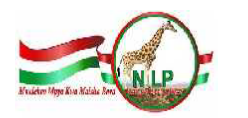
Fig.2 Party Symbol and Colours of NLP
Source: office of Registrar of political parties (2017)
A giraffe is a party symbol for the National Liberal Party (NLP). It has a gentle spirit but strong of kick. Its long neck symbolises the ability to see the future and obtain things that would be out of reach. Probably this is what the citizens look forward to; better lifestyles, employment, better social amenities etc. The leaders of the party envision the ability to discover new opportunities previously outside the citizens’ vantage point. Like, a camel, its ability to withstand the lack of water symbolises resilience and wise usage of resources. Kenya is endowed with a lot of natural resources which when put to proper use can take the country places. However, this can only be realised through visionary leadership. Despite the strengths, the giraffe becomes vulnerable when it puts its head down to drink water. NLP chooses the colours Red, Green and white almost looking like the Kenyan flag. This would imply patriotism of some sort. The red symbolises the sacrifices the founding fathers of the nation made while the white colour stands for peace, transparency and openness within the party and finally green represents the rich vegetation of the country. The three colours all signify the unity within the party.
3. The Ostrich
It is a party symbol for Diligence Development Alliance (DDA). It is seen by many as a symbol of avoidance- burying the head in the sand. The ostrich does not truly burry its head in the sand when threatened rather it assumes a posture close to the ground becoming one with the earth and appearing like a rock from a distance. This teaches us the virtues of patience and calmness in case we are faced with any threats.
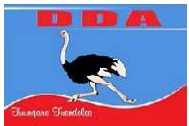
Fig.3 Party Symbol and Colours of DDA
Source: office of Registrar of political parties (2017)
Its lack of ability to fly may symbolise a deliberate choice to remain with both feet on the ground and does not aspire to fly heights. True leadership is remaining on course even when the tides are high. That is what Ostrich is. In early biblical texts, Ostrich was regarded as a cautionary tale bird, as one animal who leaves her eggs in the wild unprotected. This meaning would then mean that the DDA leaders might at some point in time desert its followers unguarded. DDA leaders used Ostrich on the move against a sky blue background and the party initials in red.
4. The crane
Crane is a party symbol for United Democratic Movement (UDM). Crane is a symbol of freedom. They can walk on earth and swim in the sea as humans do but they can also have the ability to soar high into the sky. This makes crane, among many cultures, a symbol of eternal life; the link between heaven and earth. It is generally thought to be symbols of maternal love and happiness. Many cultures consider the crane to be a symbol of maternal love and happiness.
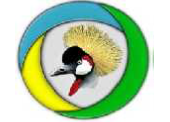
Fig.4 Party Symbol and Colours of UDM
Source: office of Registrar of political parties (2017)
The crane also has religious significance. For instance, in the Aberdeen Bestiary written in the 12th C contains the following information regarding the crane as a religious symbol, “The sentinel crane represents those who provide goods for other in common and watch over the obedience of their brothers, protecting them from devils and the incursions of this world.”
The crane is also seen as a symbol of communication and specifically believed that it was a messenger of gods. The Greeks and the Romans believed the crane to be a symbol of light. These could be the inspirations behind its choice as a party symbol by the UDM party. The party leaders would bring love, freedom and happiness among the many suffering Kenyans. Leaders of UDM would protect the citizens from all sorts of evil and suffering. The party symbol has a ring comprising three colours sky blue, yellow and green. Blue is often considered to be the safest global colour. In east Africa, it culturally signifies peace and calmness especially associated with a clear sky. Green on the other hand represents virginity and abundance of vegetation. Yellow symbolises readiness or ripeness for something. The choice of yellow by UDM could mean that time has come for true leadership from the party. The crane itself has yellow, black, white, grey and red colour.
5. The Rooster/Cockerel
One of the oldest political parties in Kenyan politics is KANU whose symbol has remained a rooster.
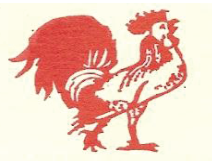
Fig.5 Party Symbol and Colours of KANU
Source: office of Registrar of political parties (2017)
According to the ancient Greeks, the rooster rose to attention and saluted the sun every morning with a hearty cry, symbolising victory over night. As such, the rooster was considered a solar emblem to the Greeks and was adopted as a sacred sign to the god Apollo, Zeus, Persephone and Attis. In politics, it stands for victory of a dark age during which the citizens suffered. At its inception, Kenya like many other African countries had suffered in the hands of colonialists. The rooster gave them hope of an end to their suffering. Its crowing early in the morning makes it a dependable figure to humanity. It then symbolises punctuality and constancy. It is associated to the saying “Rise and Shine”. This means that you have something to accomplish and the time to rise and shine is now. Self-empowerment begins with that first brave step into the dawning of a new day. The rooster is therefore the timekeeper of the world. KANU leaders would marshal the citizens to work to develop the nation. Its political philosophy “KANU yajenga inji” in the current situation would not augur well since many Kenyans who work hard don’t realise the value of their sweat. The country is full of protest and workers’ strikes.
In Christianity, the rooster is noted for crowing three times after Peter denied Christ. It therefore, became a symbol for Christ’s passion. It later signified the repentance of the saints and religious vigilance and resurrection.
6. The Horse
It is a symbol for Republican Liberty Party (RLP). The horse is a majestic and magical animal that carries wisdom and messages spoken telepathically. It can feel your energy and sense your nature. RLP leaders can therefore telepathically tell the problems that the citizens are going through and address them.
The horse is also a legendary competitor, who runs her heart out to beat out her competitors to be the one to have the crown of victory. This could imply that the RLP leaders would pose a stiff competition to the rest of the political competitors. She symbolises strength, determination, elegance and victory.
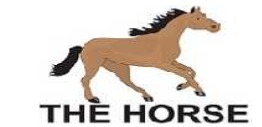
Fig.6 Party Symbol and Colours of RLP
Source: office of Registrar of political parties (2017)
Horse has the ability to take you through terrain; possibly terrain of life, ups and downs, through valleys, rivers and up the mountains. The party uses gold and black colour in their symbol.
7. The elephant
It is a symbol used in the Peoples Empowerment Party (PEP). The elephant symbolizes greatness, wit, longevity, happiness, royalty, good luck and ambition. Elephants are the bearers of kings and queens and so symbol of royalty, prosperity, temperance, dignity and power. Historically. Elephants are the largest of the land animals, yet very agile, with a magnificent trunk, and a lifespan similar to humans. The elephant is a most fascinating animal with the largest brain of all land animals.
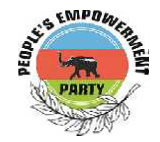
Fig. 7 Party Symbol and Colours of PEP
Source: office of Registrar of political parties (2017)
The party perhaps implies the formidable force it comes with in the fight for leadership in the country. The symbol signifies the strength and firmness of the party in protecting human rights and the rule of law through people’s empowerment. Its slogan implies empowerment in all spheres of life; economically, politically, socially among others. The posture of the elephant shows it is on the move and therefore metaphorically represents progress of the party. The party uses an olive branch in its symbol to signify peace. Most political parties use symbols for peace the fact being that Kenyans are and have been divided along ethnic lines hence the need for national cohesion and integration. A branch of an olive tree is used to signify peace. Blue, red and green are used as party colours.
8. The Bull
It is the symbol for the Party of Development and Reform (PDR). The bull is a symbol of valour, bravery and generosity. A bull cannot be dared especially by touching its horns. Politically, PDR implies that it is unstoppable from assuming power. Its sharp horns are its protection against enemy parties. It uses the four colours of the Kenyan national flag; green, white, red and black. A bull is symbol of posterity. This confirms the ideological stance of the party “ustawi”.
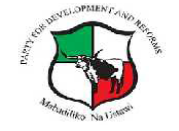
Fig. 8 Party Symbol and Colours of PDR
Source: office of Registrar of political parties (2017)
9. The lamb
Agano Party uses the lamb as its symbol. This symbol represent meekness, blameless and reconciliation. Like the sacrificial lamb, Agano party is ready to die for the sake of Kenyans who are suffering under bad leadership. As the name suggests, the symbols stands for an agreement or testament between its leaders and the citizens that it will be offer better leadership devoid of any blame or corruption.

Fig. 9 Party Symbol and Colours of Agano Party
Source: office of Registrar of political parties (2017)
The party uses the colour white in the outer ring of the shape to symbolise peace, transparency and holiness. The symbol of a lamb in white in the inner ring stands against a yellow background.
10. Fish
This is the symbol for Shrikisho Party of Kenya. The party picked on the shark. Fish symbolises a true generous mind virtuous for itself not because of its heritage. The shark in particular is a peaceful fish but when enraged, it is dangerous. It is the most feared type of sea animal. It has a sharp sense for blood. This could mean, the leadership of the party would not withstand any blood-shed in the country. Its size symbolises greatness and power in the sea.

Fig 10 Party Symbol and Colours of SPK
Source: office of Registrar of political parties (2017)
8.4.2 Colours of Political Parties in other parts of the World
Generally speaking, all over the world political parties associate themselves with colours, primarily for identification purposes, especially for voter recognition during elections. Symbols and colours can be very imperative when the overall electorate is semi-literate and illiterate. In the United States the two major political parties use the national colours red, white, and blue. Historically, the only common situation in which it has been necessary to assign a single colour to a party has been in the production of political maps in graphical displays of election results. In the words of Ninsin (2009), in such cases, there had been no consistent association of particular parties with particular colours. In the weeks following the 2000 election, however, there arose the terminology of red states and blue states, in which the conservative Republican Party was associated with red and the liberal Democratic Party with blue. Political observers latched on to this association, which resulted from the use of red for Republican victories and blue for Democratic victories on the display map of a television network.
In 2004, the association was mostly kept. However, maps for presidential elections produced by the U.S. government use red for Democrats and blue for Republicans. In September 2010, the Democratic Party officially adopted an all blue logo. Around the same time, the official Republican website began using a red logo. This association has potential to confuse foreign observers in that, as described above, red is traditionally a left-wing colour, and while blue is typically associated with right-wing politics.
According to Political Colour- the free Encyclopaedia (2003), Red usually signifies leftist, communist or socialist parties. Conservative parties generally use blue or black. Yellow is often used for libertarianism or classical liberalism.
Black is generally associated with fascist parties, going back to Ben Mussolini‘s black shirts, but also with Anarchism (Encarta 2006). Anarchism refers to the political belief that laws and governments are not necessary. In Germany and Austria, black is the colour historically associated with Christian Democrats. Black is sometimes associated with fascism, an attitude which is in favour of strong central government and which does not allow any opposition.. In the Islamic world, black flags (often with a white shahadah) are sometimes used by Islamist groups. Black in Kenya stands for Africanism, that is, the skin colour of the Kenyan people. Jubilee party uses black clapped hands; Maendeleo Chap Chap Party uses a black tarmac road with white and yellow lines. Perhaps, this was to imply that these parties belong to the Kenyan people, for Kenyans and by Kenyans.
Blue, particularly dark blue, is often associated with Conservative parties, originating from its use by that party of the United Kingdom. The field of the flag of the United Nations is light blue (azure), chosen to represent peace and hope. It has given rise to the term blue washing. In the United States, since the year 2000, the mass media have associated blue with the Democratic Party. In 2010, the party unveiled a blue official logo. In Kenya, Blue represents a water mass and water is life which as mentioned earlier stands for peace, hope, calm and love. Parties such as Chama cha Mashinani, Party of National Unity (PNU) among others.
Green is the colour for green parties worldwide. Sea green was used as a symbol by members of the Levellers in 17th century Britain; for this reason, it is occasionally used to represent radical liberalism or libertarianism, a belief that people should have the freedom to do and think as they like. Green has sometimes also been linked to agrarian movements, such as the Populist Party in the US between 1850 and 1890, and the modern day Nordic Agrarian parties. Green, considered the holy colour of Islam, is also used by some Islamists, such as Hamas. In the Kenyan context, Green stands for vegetation, fertility or even virginity. It is only fertile soil that can support health vegetation. Political parties such as FORD-Kenya, AMANI National Congress (ANC), Alliance Party of Kenya (APK) use Green.
Red is traditionally associated with socialism and communism, beliefs that everyone has an equal right to a share of the country’s wealth and that the government should own and control the main industries. Regarding this philosophy, the ruling party, Jubilee, has many times been accused of stifling devolution so that its government can be in control. In Europe and Latin America, red is associated with parties of social democracy, and often their allies within the Labour movement. In the United States, since the year 2000, the mass media have associated it with the Republican Party. Since at least 2010, the party has adopted an all red logo. However, red is used by Jubilee and KANU political parties in the Kenyan political context. Symbolically Red stands for danger and blood, the blood shed during the fight for liberation and this could possibly imply liberation of the Kenyan people from neo-colonialism.
White has been linked to pacifism, a belief that war and violence are always wrong. Historically, it was associated with support for absolutist monarchists, first for supporters of the Bourbon dynasty of France, because it was the dynasty’s colour. Later it was used by the Czarist Whites in the Russian Revolution of 1917, because their purpose was similar. In the civil war following the independence of Finland in 1917, white was used by the conservative and democratic forces which stood against the socialist red forces.
Similarly in Kenya white means peace and holiness and so many political parties use a white background to contrast their symbols. See for example, FORD-Kenya, AGANO Party, Shirikisho Party among others. In the Kenyan culture, white stands for peace, victory and holiness. All political parties claim victory for every activity and since elections are a competition none of them accepts defeat.
Black has also been extensively used in the Kenyan politics. To most parties, black represents national pride and Africanism. Africans who fought against colonialism would wish to be associated with the colour of the majority Africans: black.
According to the colour psychology, the following is a summary of meanings carried in different colour.
Table 2 The Psychology of Colour
Colour Association
1 Red Energy, Passion, Power, Excitement
2 Green Health, Regeneration, Contentment, Harmony
3 Blue Honesty, Integrity, Trustworthiness
4 Black Finality, Transitional colour
5 White Victory, Holiness
Source: Empower-yourself-with-colour-psychology.com (2010)
From the above table, it can be seen that colour and meaning depends heavily on culture and context. There are cases which cut across cultures e.g. the symbolism for white; however, a majority of the rest are significantly different in different cultures.
Important to note here is that colour plays a significant role in politics. With the majority of the electorates being illiterate or semi-illiterate, colour then increases their memory for it is widely acclaimed that a picture is worth a thousand words. Colour also informs. According to Locke (2006) colour improves readership by 40%, learning from 55-78% and comprehension by 73%. This means that colour improves readership in the political landscape. Colour attracts electorates’ attention by serving as a tool to emphasize or de-emphasize areas of interest to electorates. Lastly, colour is a symbol of identity. It isolates members to a political party from non-members. In the 2017 general elections, the colour red was associated with Jubillee Party, Orange, Blue and Green with affiliate parties to the NASA coalition. In pro-NASA zones, electorates were keen not to put on anything red.
According to Morton (2004) colour conveys meanings in two primary ways- natural associations and psychological/cultural symbolism. People are comfortable when colours remind them of similar things. For example, a soft shade of blue triggers associations with the sky and a psychological sense of calm, red is the colour of blazing fire and blood while green is the colour of vegetation.
8.4.3 Shapes and symbolism in the selected political parties
Shapes are the embodiment upon which the symbols are created by many political parties all over the world. According to Amenuke et al (1989), a shape can be defined as an area having specific character, which is defined by contour, or by a content of colour, value, or texture with a surrounding area. Shape may be regular or irregular. In most political party symbols, circle, shield-like, square and rectangle are the commonly used shapes. However, in some cases no shape is used.
- Circle
In many African traditional societies, the circle is often used to symbolise the presence and power of God (Enniful, 2010, 62). Most of the animal symbols are enclosed in a circle; an indication of the presence of the power of God. The circle also suggests vastness, eternity, perfection and equality. Amenuke et al (1989) further states that the circle signifies purity and holiness. In our case, majority of parties use this shape. They include UDM, TAK, AGANO, PEP and NLP.
- Rectangular or square
According to Amenuke et al (1989), these two shapes stand for sancity (purity) in the male as well as God’s influence on society. Rectangles also stand for stability, strength and unity. KANU and DDA uses the square and the rectangle respectively.
- The shield
A shield in war is a symbol of protection. PDR uses this shape with the symbol of a bull at the centre possibly to indicate that what the bull stands for will be fought for and protected by all means and that it will protect the welfare of the citizens.
As noted earlier, some parties were not keen on shapes. SPK and RLP simply use their party symbols without placing them in any shape. This could be attributed to lack of knowledge about the significance of shapes in politics.
8.5 Conclusion
The impact of political party symbol, shape and colours on electorates varies from one country to another depending on the literacy level. For instance in most European countries e.g. Germany, France, Sweden and Great Britain, the use of symbols and colours is minimal because of their literacy levels. The reverse is true in most African states Kenya included. Because of low literacy rates, the Kenyan electorates should know the symbols and colours and what their party stands for in order to make an informed decision. The choice of the animal symbol is culturally informed. Some symbols only make sense to specific regions of the country and therefore cannot support national positions like presidency.
8.6 Recommendations
Political parties through civic education forums should enlighten its members on the significance of party symbols and colours for easier and faster identification. The electoral commission should also regulate on the use of symbols and colour so that each registered party can easily be identified with a specific symbol and colour. Party leadership should carefully pick on a symbol that has the face of the nation.
References
Amenuke S.K., Dogbe, B.K., Asare, F.D.K., Ayiku, R.K and Baffoe, A. (1989). General Knowledge in Art. London: Evans Brothers Ltd.
Anthony J. P., and Ronal C. K., (1992). Comparative Political Philosophy, New Delhi: Sage Publications
Armorial Gold Symbolism Library Site Design and Graphics by Gold heraldry Service, Urban WebDesign line. Chicago (2004) www.herdryclipart.com retrieved May 2, 2010.
Encarta Encyclopedia online, 2003 retrieved June 18, 2010
Encarta Encyclopedia online, 2006 retrieved July 13, 2010
Locke, John (2006). The free Encyclopedia Political colour and List of political party symbols.
Morton J.L., (2004). Colour Matters: {online} Accessed on 9th June, 2010
Ninsin K. (2009), Political Parties and Political Participation in Ghana {online}: Accessed on 22nd November, 2010
Nyokabi, P. and Wabwire, A., (2012). “Why the choice of political party symbols can no longer be ignored” https://www.standardmedia.co.ke/article/2000055785/why-the-choice-of- political-party-symbols-can-no-longer-be-ignored
Palmer, S.E. (1999). Colour, consciousness, and the isomorphism constraint. Journal of Behavioural & Brain Sciences vol. 22: pp. 923-43
Wikipedia, free Encyclopedia-Colour (2009) http://en.wikipedia.org/wiki/Colour Retrieved on August 10, 2009. www.empower-yourself-with-color-psychology.com/cultural-color.html Retrieved 14th October, 2010
![]()
Download: The Pragmatics Of Zoosemy, Colour And Shape In Kenyan Political Party Symbols
